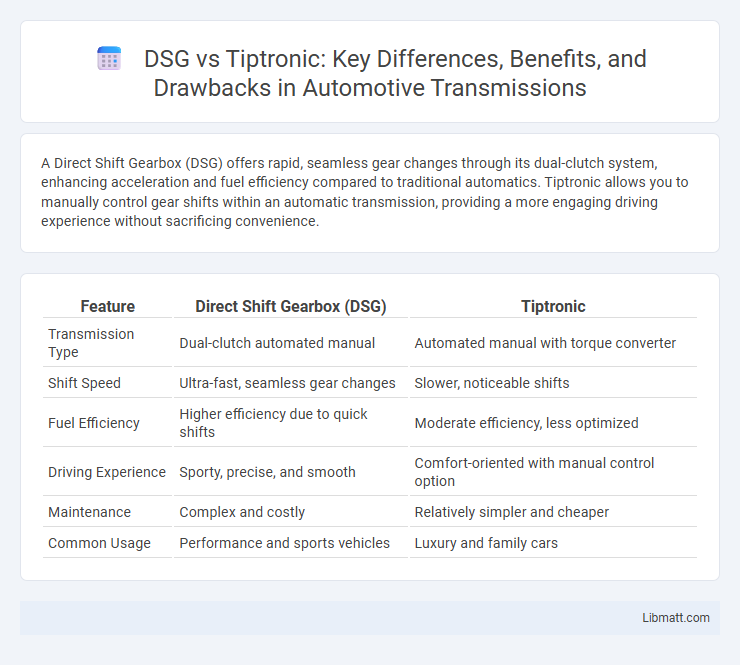A Direct Shift Gearbox (DSG) offers rapid, seamless gear changes through its dual-clutch system, enhancing acceleration and fuel efficiency compared to traditional automatics. Tiptronic allows you to manually control gear shifts within an automatic transmission, providing a more engaging driving experience without sacrificing convenience.
Table of Comparison
| Feature | Direct Shift Gearbox (DSG) | Tiptronic |
|---|---|---|
| Transmission Type | Dual-clutch automated manual | Automated manual with torque converter |
| Shift Speed | Ultra-fast, seamless gear changes | Slower, noticeable shifts |
| Fuel Efficiency | Higher efficiency due to quick shifts | Moderate efficiency, less optimized |
| Driving Experience | Sporty, precise, and smooth | Comfort-oriented with manual control option |
| Maintenance | Complex and costly | Relatively simpler and cheaper |
| Common Usage | Performance and sports vehicles | Luxury and family cars |
Introduction to Direct Shift Gearbox and Tiptronic
Direct Shift Gearbox (DSG) is a dual-clutch transmission system designed to enable faster gear changes and improved fuel efficiency by pre-selecting the next gear. Tiptronic is a type of automatic transmission with manual shift capability, allowing drivers to manually control gear changes without a clutch pedal. Both systems enhance driving experience, with DSG offering seamless shifts and Tiptronic providing greater driver engagement.
How Direct Shift Gearbox Works
The Direct Shift Gearbox (DSG) operates by using two separate clutches to engage odd and even gears simultaneously, allowing for nearly instantaneous gear changes without interrupting power delivery. This dual-clutch system enhances your driving experience with smoother acceleration and improved fuel efficiency compared to traditional automatic transmissions. DSG technology optimizes the balance between performance and comfort by combining the control of a manual gearbox with the convenience of an automatic.
Understanding Tiptronic Transmission
Tiptronic transmission offers a blend of automatic ease with manual control, allowing You to shift gears without a clutch pedal by simply moving the gear lever or using paddle shifters. Unlike Direct Shift Gearbox (DSG), which employs dual clutches for rapid, seamless gear changes, Tiptronic systems typically use conventional automatic transmissions with torque converters, prioritizing smoothness over speed. Understanding Tiptronic transmission helps You appreciate its user-friendly interface and versatility, especially in vehicles where driver engagement and comfort are equally valued.
Key Differences Between DSG and Tiptronic
Direct Shift Gearbox (DSG) features a dual-clutch system enabling faster and smoother gear changes without interrupting power flow, unlike Tiptronic, which uses a traditional automatic transmission with manual gear selection capabilities. DSG provides enhanced fuel efficiency and performance due to its precise electronic control and split-clutch design, whereas Tiptronic prioritizes driver engagement by allowing manual override through a conventional torque converter setup. The primary difference lies in DSG's seamless gear shifts tailored for sporty driving, while Tiptronic offers flexibility between automatic convenience and manual input.
Performance Comparison: DSG vs Tiptronic
Direct Shift Gearbox (DSG) delivers faster and smoother gear changes due to its dual-clutch system, significantly improving acceleration and fuel efficiency compared to Tiptronic transmissions. Tiptronic systems, typically found in traditional automatic gearboxes with manual override options, provide less immediate gear shifts, leading to slightly slower responsiveness and higher fuel consumption. DSG's ability to pre-select gears allows for near-instantaneous shifts, resulting in superior driving dynamics and performance over Tiptronic setups.
Fuel Efficiency: Which is Better?
Direct Shift Gearboxes (DSG) generally offer better fuel efficiency compared to Tiptronic systems due to their quicker gear changes and reduced power loss during shifts. DSG uses dual clutches to pre-select gears, minimizing engine disruption and optimizing fuel consumption. Your vehicle benefits from smoother acceleration and lower fuel usage with a DSG, especially in urban and stop-and-go driving conditions.
Driving Experience and Comfort
Direct Shift Gearbox (DSG) delivers rapid, seamless gear changes that enhance your driving experience by providing smooth acceleration and precise control. Tiptronic offers manual gear selection within an automatic transmission, giving drivers more engagement and control but often with slower shifts compared to DSG. Overall, DSG prioritizes comfort through quick, nearly imperceptible shifts, while Tiptronic balances control with traditional automatic ease.
Maintenance and Reliability Factors
Direct Shift Gearboxes (DSG) generally demand more meticulous maintenance due to their complex dual-clutch system, which requires regular fluid changes to prevent premature wear and ensure smooth operation. Tiptronic transmissions, being a more traditional automatic system with manual shift capabilities, often offer greater reliability with less frequent maintenance but may sacrifice some shifting speed and efficiency. Your choice impacts long-term servicing costs and dependability, with DSG favoring performance enthusiasts willing to invest in upkeep and Tiptronic appealing to those prioritizing durability and lower maintenance demands.
Pros and Cons of Direct Shift Gearbox
Direct Shift Gearbox (DSG) delivers rapid gear changes and improved fuel efficiency compared to traditional automatic transmissions, making it ideal for performance-oriented driving. Its complex dual-clutch system can result in higher repair costs and occasional jerking during low-speed maneuvers, which may affect driving comfort. Your choice depends on whether you prioritize sporty responsiveness or smoothness in everyday driving.
Pros and Cons of Tiptronic Systems
Tiptronic systems offer the benefit of seamless manual gear selection combined with automatic transmission convenience, enhancing driver control and engagement without the need for a clutch pedal. They provide smooth gear shifts, improved driving comfort, and adaptability to various driving conditions, but can experience slight lag and increased wear compared to fully automatic systems. However, Tiptronic transmissions may not deliver the same level of efficiency or quick shift response as Direct Shift Gearboxes (DSG), which use dual clutches for faster and more precise gear changes.
Direct Shift Gearbox vs Tiptronic Infographic

 libmatt.com
libmatt.com